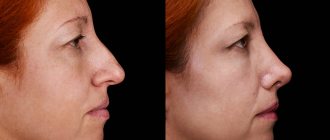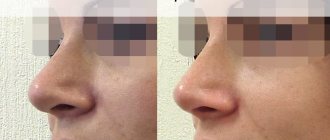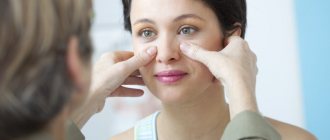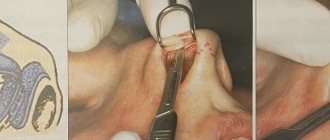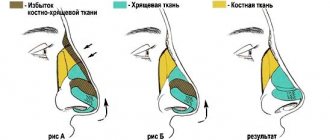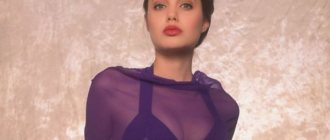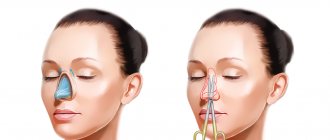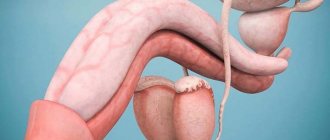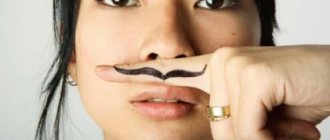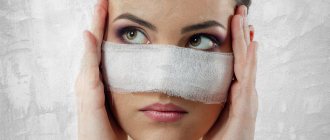Rhinoplasty is a complex operation with its own set of recommendations for the rehabilitation period. Every patient wants the healing process to go smoothly and without complications. The patient's efforts in caring for the postoperative nose are very important. This is a direct path to faster recovery and good results. Almost all surgeons strongly recommend rinsing the nose after rhinoplasty - this is a very useful procedure that has a positive effect on the nasal mucosa, and also gives physical comfort to the patient, because rinsing helps the nose to breathe faster.
How to properly rinse your nose?! We will tell you in our article.
During the first 2-3 weeks after rhinoplasty, it is necessary to rinse the nose with a weak solution of sea salt; the solution can be made at home, or you can buy it so as not to rack your brains about how to properly dilute the solution. Pharmacy options that are easy to use - Dolphin, Aquamaris, Aqualor and many other brands.
The composition is the same - sterile sea water.
Technique for rinsing the nose after rhinoplasty step by step:
- you need to bend over a sink or basin;
- tilt your head to the side;
- take a breath;
- hold the breath;
- the nozzle from the rinsing agent bottle must be inserted into the respiratory passage;
- make several sprays, first in one nostril, then in the other;
- after which it is necessary to blow your nose (gently blowing air) from each nostril in turn, covering the adjacent one;
- After you have blown your nose, it will be useful to drop a dropper of peach or apricot oil into each nostril and lie on your back for 10 minutes.
The importance of physiotherapy after rhinoplasty
During the postoperative period, a lot of restrictions must be observed. This list also includes many cosmetic procedures. But, there are those that are aimed specifically at the recovery of the patient after surgery. The procedures help restore tissue, reduce swelling and hematomas that occur after rhinoplasty. To alleviate the patient’s condition after rhinoplasty, physiotherapy procedures are intended, which include special massage. Such actions serve as prevention for the formation of callus after rhinoplasty.
General recommendations for rinsing the nose after rhinoplasty:
- it is necessary to rinse from the 3rd day after rhinoplasty, in the absence of severe bleeding and tampons in the nasal passages;
- It is necessary to rinse the spout at least 3-4 times a day;
- You need to rinse your nose for 2-3 weeks after surgery;
- You can also rinse your nose longer if you experience discomfort (dryness, congestion).
Rinsing the nose after rhinoplasty is an important point in proper rehabilitation. Be beautiful and healthy.
© PlasticRussia, 2022. All rights reserved. Full or partial copying of site materials without the consent of the portal administration is prohibited.
0
Septoplasty: after surgery
01.08.2018
Since septoplasty is a relatively simple operation, the occurrence of complications after it is unlikely. Nevertheless, due to the differences and individuality of each patient, great importance should be given to following all doctor’s during the recovery period after septoplasty. A number of combined reasons influence the patient’s return to his normal lifestyle. This includes accuracy and timeliness of procedures, hygiene, and avoidance of alcohol and tobacco consumption.
As a rule, the patient is in the hospital for no more than two days. This is the day of the operation and the day after it. On the first day after the operation the surgeon himself will carry out hygienic procedures for the patient: this includes washing the nose , removing dry particles, and applying ointments. This is necessary for two main reasons. Firstly, the surgeon who performed the operation familiar with your nose better than you are. Well, secondly, the patient may develop a fear of harming himself after the operation , a kind of psychological barrier. This barrier will be overcome by a specialist who explains during the manipulation process not only the procedure itself, but the need for it. And in the case when the patient does not have any barriers, the doctor will be able to warn against excessive zeal. Subsequently, the patient carries out hygiene procedures independently. Of course, the recovery process will be accompanied by discomfort and headaches (it is unlikely that it will be possible to do without it). There is no need to be afraid, except for a course of antibiotics and based on the results of your well-being, the doctor will prescribe you additional medications. All that is required of you is strict adherence to all procedures assigned to you.
Rehabilitation period after septoplasty
During the rehabilitation period, it is worth visiting a doctor , not only for the purpose of self-soothing, but also for the purpose of possible adjustment of treatment. After surgery, swelling appears , which usually goes away within a week. For a speedy recovery, at first it is necessary to avoid visiting the bathhouse and swimming pool, do not take hot baths, drink hot or cold, or stay in the sun for a long time. In general, avoid contrasting temperatures in all forms as much as possible. It is worth remembering that during this period the body is weakened and is struggling for a speedy recovery, do not create additional problems for it. Protect yourself from physical activity for a month after surgery . Don't catch a cold and take care of all kinds of infectious diseases. All this will only significantly complicate the rehabilitation . Full recovery usually occurs two to three weeks after surgery . And then you will be able to fully evaluate the correctness of the decision you made. You will not only be able to breathe normally, but also get rid of a number of chronic diseases caused by a deviated septum. For many, septoplasty becomes a real salvation.
Published in Articles without category Premium Clinic
When is consultation with an otolaryngologist necessary?
If you suspect sinusitis, a persistent runny nose, ear inflammation, or partial hearing loss, you need to consult a specialist. Deep cleansing of the nose, sinuses, and ear canal is safe to do only in a clinic. An ENT specialist will assess the condition, prescribe medicine, and prescribe physiotherapy.
Cleansing the ENT organs is an auxiliary action in the treatment of inflammatory processes. They are combined with drug therapy and physiotherapy. The frequency and duration of procedures will be determined by the otolaryngologist.
Medical appointments are conducted by specialists with about 10 years of experience. Professional cleansing of ENT organs is available for patients of any age. It is carried out quickly, painlessly, manually or using modern equipment.
Treating your nose correctly!
Each of us has encountered a runny nose throughout our lives... For treatment, specialists often prescribe drops and sprays into the nose... It would seem that it might be easier to put drops on the nose of yourself, a child, or a relative? But nevertheless, this simple procedure has nuances and features . We will talk about them. When a doctor prescribes several medications at the same time, the following order must be observed: 1. Relieve swelling. 2. Rinse your nose. 3. Instill medications (antibiotics, mucolytics, immunomodulators). Vasoconstrictor medications will help relieve swelling... But you need to remember that taking it for more than 5 days (and some for more than 3) leads to addiction and the nose will refuse to breathe on its own. Uncontrolled use of this group of drugs thins the mucous membrane, which leads to a complication - atrophic rhinitis due to long-term narrowed blood vessels and lack of oxygen. This group of drugs should also be used with caution by people suffering from hypertension, there is a danger of increased pressure due to the vasoconstrictor effect.. Algorithm The medication is taken as follows: you need to stand up and tilt your head forward. Inject the required amount of the drug into the nose and massage the wing of the nose. Then repeat with the other half of the nose. Nasal rinsing is carried out with saline solutions purchased at the pharmacy. You can rinse your nose with regular saline solution. These medications help moisturize the mucous membrane and remove mucous membranes containing pathogenic bacteria. It can be used daily as a prophylaxis against influenza and ARVI, as well as for hygienic purposes. As a rule, manufacturers in the instructions describe in detail the method of using the drug for both adults and children. The main features are that most of these formulations are administered into the nose at an angle. The head must be tilted down and slightly to the left, then inject the required amount of the drug into the right nostril (that is, the nostril that is on top). Then repeat with the other half of the nose. If you need to rinse your nose, the medicine is injected under pressure and should flow out of the left nostril. Antiviral agents. Before using them, it is better to clean your nose with saline solution, this will improve the effect of the treatment. Next, you need to take a horizontal position and tilt your head back strongly. Inject the medicine into the nostril and massage. Repeat with the other nostril. Antiviral agents and immunomodulators do not need to be taken out. If the drug gets into the throat there will be no harm, but on the contrary, an additional antiviral effect will occur. When prescribing antibiotics, the nasal passages must be rinsed!!! Since these drugs are prescribed, as a rule, for viscous and thick mucus... Drops with antibiotics need to be instilled (injected) for at least 5-7 days. Children under a certain age should not use sprays. Therefore, it is important to read the instructions to see if there are any contraindications based on age. To correctly introduce the drug into the nasal sinuses, the baby must be laid on his back, tilt his head back and inject the drugs into each nostril. Some drugs are administered at an angle and while inhaling. This is indicated in the instructions. If you follow these simple rules, then recovery will come sooner and your nose will thank you with its healthy, free breathing. Our center’s pharmacy is also always ready to help you.
THERE ARE CONTRAINDICATIONS - YOU MUST CONSULT A DOCTOR
You can make an appointment by phone, at the medical center reception and on the website
Contraindications during rehabilitation
After the operation, the doctor must give you recommendations on how to behave during the rehabilitation period. In order to minimize unpleasant consequences, you should strictly follow all instructions. What is prohibited after rhinoplasty:
- lift something heavy:
- wear glasses; during rehabilitation they should be replaced with lenses;
- swim in pools, ponds, visit baths and saunas;
- take a contrast shower or bath;
- sleep on your back;
- sunbathing or being exposed to sunlight for a long time
It is very important to avoid acute bacterial infections. A cold may cause sneezing, which should be avoided. It is worth paying attention to bad habits such as alcohol and smoking. Doctors recommend giving up alcohol due to its negative impact on the healing process. For about three months after rhinoplasty, you should limit sports activities. This ban is especially important for athletes who engage in combat sports. After rhinoplasty, the nose should be protected from injury as much as possible. Doctors recommend limiting yourself to walking and doing yoga.
Correction of dry nasal mucosa
Most modern people quite often experience unpleasant sensations characterized as “dryness of the nasal mucosa.” It is expressed in nasal congestion, often alternating, itching, burning, crusting in the nasal cavity, and decreased sense of smell. In addition to the feeling of discomfort, dryness of the nasal mucosa negatively affects the filtration function of the nose - dust particles, bacteria and viruses contained in the air almost freely enter the lungs during breathing.
Various factors can lead to dryness of the nasal mucosa. Quite often, “dry nose” is a side effect of certain medications, primarily antihistamines and drugs containing atropine. The most common is the adverse effects of climate and ecology, staying in rooms with central heating and air conditioning. The humidity of the nasal mucosa is negatively affected by inhalation of hot air, in particular from smoking, rarefied air (during air travel and vacations in the mountains), dust in the air in a number of industries - cement, chemical, etc. In addition, this condition can also be a symptom of a general disease.
The mucous membrane of the nasal cavity is covered with a special ciliated epithelium, consisting of ciliated cells that ensure the transport of mucous secretions (Fig. 1).
Ciliated cells have 250–300 cilia, 7 microns long and 0.3 microns high. Each cilium consists of 9 pairs of microtubules arranged in a ring and surrounding two unpaired central microtubules. The movement of the cilia of the ciliated epithelium of the nasal mucosa is carried out through the sliding of microtubules (Satir P., 1974). Energy for movement is provided by ATP, which is broken down by dynein. Dynein is a Ca/Mg-dependent ATPase. The motor cycle begins with the addition of ATP to the dynein molecule. Cleavage of the phosphate ring during ATP hydrolysis leads to the connection of the dynein molecule and the tubulin molecule of the adjacent outer doublet and is accompanied by conformational changes in the dynein molecule - bending and displacement of the microtubule at a certain distance. This, in turn, causes a new ATP molecule to attach to dynein and break its bonds with tubulin, causing the dynein handle to return to its original shape. The whole cycle is repeated again (Kiselev A.S., Tkachuk I.V., 2006).
The movement of the cilia is strictly directed - from the vestibule of the nasal cavity towards the nasopharynx. Mucociliary clearance is provided by nasal secretions. The source of the secretion covering the epithelium of the nasal cavity is the mucous glands of the nasal mucosa, goblet cells, extravasation from subepithelial capillaries, lacrimal glands, and the secretion of specialized Bowman glands from the olfactory zone of the nose. The volume of nasal secretion in 24 hours ranges from 100 ml to 1–2 liters. The mucous membrane of the posterior two-thirds of the nose is renewed every 10–15 minutes. The function of the cilia is optimal at a temperature of 28–33 °C, a sufficient amount of secretion with a pH of 5.5–6.5. Loss of moisture, a decrease in temperature to 7–10 °C, and an increase in the pH of the secretion to more than 6.5 causes the cilia to stop vibrating.
Elimination of dryness of the nasal mucosa is facilitated by applying an isotonic solution to it. At the same time, the rheological properties of mucus are normalized. It is believed that trace elements contained in an isotonic solution, such as Ca, Fe, K, Mg, Cu, help to increase the motor activity of cilia, activate reparative processes in the cells of the nasal mucosa and normalize the function of its glands. The listed microelements are contained in preparations that are prepared from sea water, sterilizing it and bringing the salt content to isotonic concentration (Otrivin More, Marimer, Aqua Maris, Salin, etc.), and from mineral spring water, which has medicinal properties (salt).
One of the new drugs in this group is Otrivin More, which is a purified, disinfected isotonic solution of ocean water from Brittany, extracted in an ecologically clean area of the Atlantic Ocean, rich in natural microelements. It contains 18 minerals and trace elements.
We examined and treated 50 patients of both sexes aged from 21 to 43 years with complaints of “dry nose” caused by prolonged stay in rooms with dry and/or rarefied air. In the treatment of the main group (25 patients), Otrivin More was used in the form of irrigation of the nasal mucosa 2 times a day for 10 days; in the second (control) group (25 patients), an oil solution of tocopherol acetate and retinol palmitate in the form of drops 2 times a day. The distribution of patients by gender and age, as well as by the severity of clinical manifestations in both groups was comparable. Every three days, the dynamics of the main symptoms were assessed: difficulty in nasal breathing, dryness in the nasal cavity (including the patient’s subjective sensations), the nature and amount of nasal discharge, the state of mucociliary transport (saccharin test).
At the end of the course of treatment, a positive clinical effect was obtained in 42 patients, of which 23 were from the main group and 19 from the control group. In 8 (16%), including 6 from the control group (24%), no positive dynamics were recorded. In the group of patients receiving Otrivin More, the regression of pathological signs was significantly more rapid compared to the control group, which was confirmed by the results of a study of mucociliary transport. On average, the decrease in mucociliary transport time with the use of the drug was 6.9 minutes. In the control group, this figure was 4.3 minutes (Fig. 2).
Changes in mucociliary transport parameters correlated with rhinomanometry data and changes in the clinical picture, which took into account subjective symptoms assessed using a patient questionnaire. The drug was well tolerated by all patients. In addition, all patients noted the ease of use of the drug, while the use of oil drops by the majority of patients in the second group (24 people) was characterized as “inconvenient.”
Thus, Otrivin Sea can be recommended as a means for caring for the nasal cavity not only for patients with rhinitis, including atrophic ones, but also as a means of daily hygienic care for the cavity during the heating season, as well as for people who stay in dry rooms for a long time. and/or rarefied air.
Literature
- Satir P. How cillia move // Scientific American. 1974. Vol. 231. P. 45–46.
- Kiselev A. S., Tkachuk I. V. Spray Aqua Maris for diseases of the nose and paranasal sinuses // Pharmacy Weekly. 2006, March 27, No. 12 (533).
O. V. Zaitseva , Candidate of Medical Sciences, National Research Center of Otorhinolaryngology, Federal Medical and Biological Agency of Russia , Moscow
In what cases do doctors recommend rinsing your nose?
- Rhinitis. A runny nose can be the result of an infection or a reaction to an allergen. Rinsing the nose in such cases eliminates particles that irritate the mucous membrane and removes accumulated mucus, significantly alleviating the patient’s condition.
- Sinusitis. This is an inflammation of the sinuses, in which it is quite difficult to deliver medicine to the inflamed area. A common form of this disease is sinusitis. In accordance with your doctor's recommendations, you can carry out rinsing procedures at home, but for sinusitis it is better to perform them in the hospital.
- After surgery. Rinsing is necessary for careful restoration of the mucous membrane.
How to rinse a child's nose?
Otolaryngologists are unanimous in the effectiveness of irrigation procedures for young children. Aspirations can be performed on children from birth. The nasal canals in children are narrow and short, which explains their obstruction during colds and allergies. As a result of nasal congestion, infants have difficulty sleeping and eating, and their weight decreases. To rinse the nose of young children, it is better to use professional products and aspirators instead of pears.
Nasal shower and irrigation can be used from 4 years of age. When choosing pharmaceutical rinsing products, you should be guided by the age restrictions specified by the manufacturer.
Pharmaceutical nasal rinses
The most popular products are saline solution or sea water-based products.
Preparations with sea water, which are sold in pharmacies, contain components such as selenium, potassium, iodine, magnesium and other trace elements. In addition to washing, they have a therapeutic effect on the mucous membrane:
- eliminate inflammation;
- thins and removes mucus;
- remove swelling;
- moisturize the mucous membrane;
- increase local immunity.
They are used for therapeutic and prophylactic purposes, to maintain optimal functioning of the respiratory system. The safe composition allows the use of such products for rinsing the nose in children and pregnant women. For example, a solution of sea water Sialor aqua (release form - drops) can even be used for infants.
In addition, it has a complex effect on the mucous membrane: moisturizes, reduces inflammation and promotes mucosal regeneration.
Drops and sprays with sea water relieve the condition of a runny nose and allergies, washing away the irritant from the nasal cavity.
Additionally, pharmaceutical products with sea water may contain medications, aromatic oils, and plant extracts. The composition of seawater is similar to the composition of interstitial fluid. When washing, there is no unpleasant sensation, such as when using ordinary water.
Ear toilet: who needs it, how it’s done
Professional treatment of the auricle and ear canal is indicated for otitis media, as well as for the formation of cerumen plugs or to remove a foreign object. Before visiting an otolaryngologist, you may also need to clean your ear so that the otolaryngologist can examine the organ and assess the condition of the eardrum.
If necessary, the entrance to the ear is treated with an antiseptic to remove pus, skin scales, and dirt. Next comes the basic cleansing. There are two ways:
- Dry. This is done using a special probe. Sterile cotton wool is wrapped around the tip of the instrument. The healthcare worker carefully inserts the instrument into the passage and gradually cleans it with rotating, blotting movements. Contaminated cotton wool is replaced several times with new one. The manipulations are repeated until the cotton tip stops getting dirty. The ENT monitors the process using an otoscope. The probe is immersed into the ear no more than 2–2.5 centimeters.
- Wet. It is used to treat the ear during an inflammatory process or to remove wax plugs. Use an antiseptic or saline solution. To create the necessary pressure, take a large syringe. There are also devices - irrigators with special attachments. Before getting rid of the sulfur plug, it is softened with special drops or hydrogen peroxide.
After cleaning the ear canal, the outer ear is treated with an alcohol solution, an antiseptic, or boric acid of your choice.
Reviews of massage after rhinoplasty
Marina, 30 years old I have long dreamed of rhinoplasty, as I had a fairly noticeable flaw - a long tip of the nose. This shortcoming really interfered with my life; I was teased at school; as a teenager, boys didn’t pay attention to me. I found out about rhinoplasty by accident when girls on a forum were discussing their noses. One of the girls wrote that she had rhinoplasty in Moscow, a famous clinic. I went to the website and made an appointment with a surgeon. About a month later, after I passed all the tests before rhinoplasty, I went in for surgery. Rehabilitation was very difficult, when after the procedure I looked at myself in the mirror and cried for half a day. Not only was there large swelling, but a thickening appeared on the nose. The doctor said that this happens, and you need to do a special massage. I was afraid to do it myself, and went to the gym. Because I was scared to look at my nose, let alone touch it. I was afraid that the operation was unsuccessful and a hump formed on my nose. Thank God, it really helped, the lump disappeared. I had to put up with the swelling, and it soon went away. The result is excellent. The tip became smaller, and there was more fear before the operation itself.
